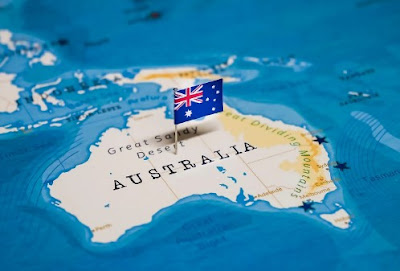Overview: The US dollar is trading with a firmer bias against nearly all the G10 currencies ahead of Federal Reserve Chairman Powell's semi-annual testimony before Congress. Speaking for the Federal Reserve, the Chair is likely to stay on message which is higher rates are necessary to cool the overheating economy. This comes on the heels of the Reserve Bank of Australia's 25 bp hike and indication that it is not pre-committing to an April hike. The Australian dollar is the heaviest of the major currencies, falling around 0.8% to a new low for the year. Most emerging market currencies are also trading lower, though the Mexican peso, the strongest currency this year, is firm near its recent highs.
Chinese stocks in the mainland and in Hong Kong traded lower as the National People's Congress continues. The CSI 300 fell by nearly 1.5%. Other large bourses in the area rose. Europe's Stoxx 600 is recouping yesterday's minor loss, and US futures are trading with a slightly firmer bias. Bond markets are extending yesterday's gains. European benchmark 10-year yields are off mostly 7-11 bp, with the peripheral premium narrowing. The 10-year US Treasury yield is off three basis points to about 3.93%. Despite news that China added gold to its reserves for the fourth consecutive month, the yellow metal is paring last week's gains for the second consecutive session. April WTI initially extended its rally to almost $81, the highest since late January, has reversed lower to approach $80.
Asia Pacific
As anticipated, the Reserve Bank of Australia raised the cash target rate by 25 bp to 3.60%. However, the accompanying statement suggests that "whether and how much further” to move will be determined by the upcoming data. The Australian dollar fell in response to what is perceived as a dovish hike. Governor Lowe speaks tomorrow, and the swap market leans toward a pause in April. There are three RBA meetings in Q2, and swaps market has the policy rate near 3.90% at midyear. Next week's jobs report will help shape market expectations. Separately, Australia reported an A$11,7 bln January trade surplus, somewhat smaller than expected on a 1% rise in exports and a 5% (month-over-month) increase in imports. Last year, Australia recorded an average monthly trade surplus of A$11.7 bln surplus and last January, it stood at nearly A$12.4 bln.
The 4.1% year-over-year decline in January's Japanese real wages illustrate the cost-of-living squeeze in Japan. It matches the largest drop since 2009 and was larger than expected. Moreover, the 0.1% gain in December was revised to a 0.6% decline. Nominal cash earnings rose by a disappointing 0.8% (median forecast in Bloomberg's survey was for a 1.8% increase). In January 2022, they had risen by 1.1% year-over-year. Relief will come in two forms. The first is lower price pressures, helped by the government's initiatives, including a 20% discount on household electricity rates and efforts to hold down natural gas prices. Second, is the spring wage round, where average pay is seen rising around 3%. Bank of Japan Governor Kuroda presides over his last policy meeting later this week. The market has bid up one week volatility in the exchange rate from below 10% for most of last week to 15.7% before the weekend and almost 17% today. To give it some context, note the 50- and 100-day moving averages are slightly above 13.6%.
China reported weaker imports and exports in the January-February period. Exports were off 6.8% year-over-year (-9.9% December) and imports were down 10.2% (-7.5% in December). The trade surplus over the two months was almost $117 bln. Exports to the US, Europe, and Japan fell while shipments to Southeast Asia increased. Electronic exports fell while autos, chasses, and refined oil exports rose. Imports of edible oils, coal, and rare earths increased the most in volume terms. Semiconductors parts and steel products saw the largest declines. Imports of crude oil and natural gas fell. Separately, China reported that the value of its reserves fell to $3.13 trillion in February, a drop of $51.3 bln. This was close to our $50 bln estimate based on valuation adjustments.
The dollar remains confined to a narrow range against the Japanese yen, inside yesterday's (~JPY135.35-JPY136.20) range. It looks set to probe the upper end but the $570 mln options that expire today at JPY136.50 look safe ahead of Fed Chair Powell's testimony. The Australian dollar has fallen through the shelf it had seemed to forge around $0.6700. It has been sold slightly through $0.6670 to approach the (50%) retracement of the rally since the multiyear low was set in mid-October near $0.6170. A break of $0.6660 could spur losses toward $0.6600. That said, the intraday momentum indicators are oversold. The greenback edged slightly higher against the Chinese yuan to reached almost CNY6.9425, a new five-day high. The PBOC set the dollar's reference rate somewhat weaker than expected at CNY6.9156 compared with the median in Bloomberg's survey of CNY6.9174.
Europe
The debate at next week's ECB meeting is not about the 50 bp hike that seems to close to a sure thing. It is about the forward guidance. The ECB has come as close as it ever does to pre-committing to the 50 bp hike last month and this month. The more dovish ECB members are reluctant to pre-commit to another half-point hike in May. At the other extreme is Austria's Holzmann who suggested that there may be a need for three more half-point moves. The swaps market was pricing in around a 3% year-end rate near the end of last year. With risk of an energy crisis easing, the year-end policy rate was seen closer to 3.25% in early February. Sticky inflation, favorable economic news, and hawkish official comments have spurred a move to almost 4.0%. The risk is that the adjustment is not over.
German factory orders jumped 1.0% in January. The median forecast in Bloomberg's survey expected a 0.7% decline. The December gain of 3.2% was revised to 3.4%. Domestic orders disappointed and fell 5.3% in January offset the 5.3% gain in December. Foreign orders rose by 5.5% after a 2.0% gain in December. However, orders from other eurozone members were soft, falling by 2.9% after December's sharp 10.7% gain. The strength of the factory orders was due to the 11.2% jump in non-EMU orders, which had fallen by 3.1% in December and 4.4% last November. Capital goods, notably aircraft and motor vehicle engines orders were particularly strong. Tomorrow, Germany reports January retail sales (expected to recover from the 4.9% decline in December) and industrial production (expected to rise 1.4% after falling 3.1% previously).
The euro settled above its 20-day moving average yesterday (~$1.0660) for the first time since early February. However, there has been no follow-through buying and the euro is straddling the moving average today in quiet turnover. The euro approached $1.07 yesterday and today and it held. The single currency has not traded above $1.07 since February 20 and has not closed above it since February 14. Sterling does not appear to be going anywhere quickly. The bounce to $1.2065 today, a four-day high, has been repulsed and sterling is back to straddling the $1.20 level. The intraday momentum indicators are stretched and a retest of nearby resistance around $1.2040-50 looks likely in early North American activity.
America
Federal Reserve Chair Powell begins his two-day testimony before the Senate Banking Committee today. His prepared remarks are expected to be consistent with the recent assessment that further rate hikes will be necessary to ensure inflation will head back to its target. The NY Fed sees the pressures in the global supply chain below the historical average. That would seem to put the onus on "too hot of demand," which some may try to lead Powell into criticizing fiscal policy. He is unlikely to fall for the trap if it is too obvious. Powell may hint what is already assumed, that the median dot is likely to be raised from December's 5.1%. At the same time, Powell may seek to balance the data-dependency with the volatility of high-frequency data.
The Bank of Canada meets tomorrow. It is the first meeting since Governor Macklem announced a conditional pause in late January. Most data have not deviated significant from expectations, except for the January jobs growth (121k full-time positions were filled), but average hourly wage rate for permanent workers moderated. We suspect another outsized job report and higher wages could get the central bank to re-consider it pause. The swaps curve has about a 50% chance of another quarter point discounted in Q3 and Q4.
The Canadian dollar continues to trade sideways in the well-worn range first traced out on February 24 (~CAD1.3530-CAD1.3665) and has not been out of that range since. More immediately, last Friday's range (~CAD1.3555-CAD1.3645) is confining the price action. Softer US rates and steady stocks should see the exchange rate continue to trade broadly sideways. The greenback remains in the trough, a five-year low set at the end of last week, against the Mexican peso. It was unable to rise above MXN18.04 yesterday and, so far today, is holdings below MXN18.0130. It is the third consecutive session that has traded below MXN18.00. The flattish consolidation may continue today.
Full story here Are you the author? Previous post See more for Next post
Tags: #USD,Bank of Canada,China,Currency Movement,ECB,Featured,federal-reserve,Germany,Japan,newsletter,RBA































